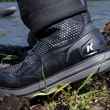Anglers have no shortage of options for gear designed to help keep them warm when heading out into the typically frigid conditions encountered when fly fishing in winter. Products based on natural materials like wool and down have been available for as long as most of us can remember and advances in technology continue to make synthetic fabric, insulation and outlayers better and better. Many of the products on the market today, whether a baselayer, warmth-providing midlayer or an expedition-proof, damn-the-elements outlayer allow anglers to get out on the water and stay out longer in the worst of conditions. The best of these products don't come cheap, but anglers are noticing the true value of comfort and safety on the water, and more and more of them are ponying up.
Some of these anglers, however, continue to handicap their technical winter gear with the heartbreak of cotton. Those bomber waders and the $400 Gore-Tex wading jacket you saved up for all summer aren't going to do their jobs if you're donning blue jeans and a hoody underneath them. But they're not failing because they're over-hyped pieces of junk, they're failing because you crippled them with winter's worst fabric.
Cotton may indeed be the "fabric of our lives," but it has no place on any icy winter stream. Not in any amount. That means your favorite t-shirt stays home and your game-day sweatshirt gets stowed. And don't even think about wearing those old-school waffle-textured long johns. Cotton boxers or socks? Nope. And again, blue jeans? Stop it.
The reason is simple, and still one that is seemingly unknown to hordes of people out there: cotton holds water. Unlike natural fibers like wool and synthetics like Patagonia's Capilene, cotton doesn't wick water. Instead, cotton gets saturated and holds water. Wet fabrics steal heat from your body at an alarming rate. In addition to being uncomfortable, wet cotton can literally be dangerous during low winter temperatures and can lead to a much more rapid onset of troubling developments such as frostbite and hypothermia. At best, cotton is going to leave you trudging along the banks of your winter rivers cold and clammy, possibly with two numb feet in tow, translating into shorter days on the river. Isn't that enough?
Unfortunately, leaving the cotton at home means digging into the wallet a bit more. While cotton options can range from cheap to dirt cheap, winter-friendly fabrics and garments can often be pricey. But, their price is often properly proportioned to their performance in the field. For our money, there's still no better option for fabrics that touch the skin than Merino wool. Smartwool's Merino 250 is still made with 100% Merino wool, and provides excellent warmth and breathability. Merino-dominant blends that combine the warmth and skin comfort of Merino with some of the advanced wicking properties of synthetic fabrics like Patagonia's Capilene are excellent choices as well. But all Merino-based products are going to carry a higher price tag. If spending Merino money isn't an option, full synthetic options, like Simms' fleece midlayers can be the next best thing.
When out on icy waters, gear to keep you warm and safe on the water is as important as any other piece of gear you've lugged to the river with you that day. So explore the options, explore the costs, but don't be afraid to invest in proper winter layers. And whatever you do, leave the cotton at home. All of it.































Comments
DDon replied on Permalink
Cotton stinks for all active pursuits, not just cold weather ones.
ginkthefly replied on Permalink
Merino might not perform as well as some of the newer technical synthetics, but it certainly smells better, and that matters, even to a dirt bag like me.
bob volpe replied on Permalink
Capilene period. The best base layer ever invented. Lasts a long time if cared for properly and doesn't make you smell like a locker room. Don't forget the feet. Silk or polypro sock liners under Smart Wool socks help wick moisture quickly and also help prevent blisters.
Matt replied on Permalink
I do a lot of steelhead fishing on Steelhead Alley and over the years have seen the improvements in cold weather clothing and how dressing properly will really allow you to enjoy a trip. Depending on how cold it is I wear either a 200 weight or 300 weight polar fleece pants. I like the style with the sewn on stirrups so when you put your foot in the stirrup goes under your foot and then you don't have to tuck your socks into your pants to keep the pants from riding up. I wear a very thin pair of poly socks and put a thicker Gander Mtn synthetic sock over them. If you are really a cold weather guy and want to fish December and January then I would recommend a pair of the Patagonia capilene long underwear.
For my upper body I wear a T-shirt of 1005 poly over which I wear a UA long sleeve shirt. I follow this with a 200 or 300 weight zippered fleece jacket and a quality Gore Tex rain coat whether it is raining or not it breaks the wind. For my hands I bring two pairs of Simms fingerless gloves so if one gets wet I can squeeze it out and put on the other pair. I usually also carry one of those hand warmers that burn for hours on a stick of solid fuel. For a head covering I use one of those synthetic material caps with the ear flaps and built-in balaclava to cover my mouth and cheeks if it is really horrible.
bob volpe replied on Permalink
There is a saying in the Search & Rescue community.
"Cotton kills"
Glenn Dotter replied on Permalink
How did the mountain men survive without all the new tech expensive gear we have that is made with cheap labor of far east countries and then sold for exhorbative prices here.
I dont and won't look like a flyshop or acatalog on the river, but I'm never cold and I dont sweat. If you sweat, you are over exerting and over dressed, and probably out of shape. Sadly, while new materials are good. You dont have to spend a fortune to stay warm. The article suggests that if you dont spend the money you will wear cotton. This is typical of where the flyfishing industry is going. If you dont buy that $1000 rod or that $800 reel with $120 line and $600 waders, you won't catch fish either. My buddy and I certainly dont look as pretty, and we build our own rods and tie our own flies, but I'm willing to bet we catch more fish. You are turning the sport into a rich man's elite sport.
Pages